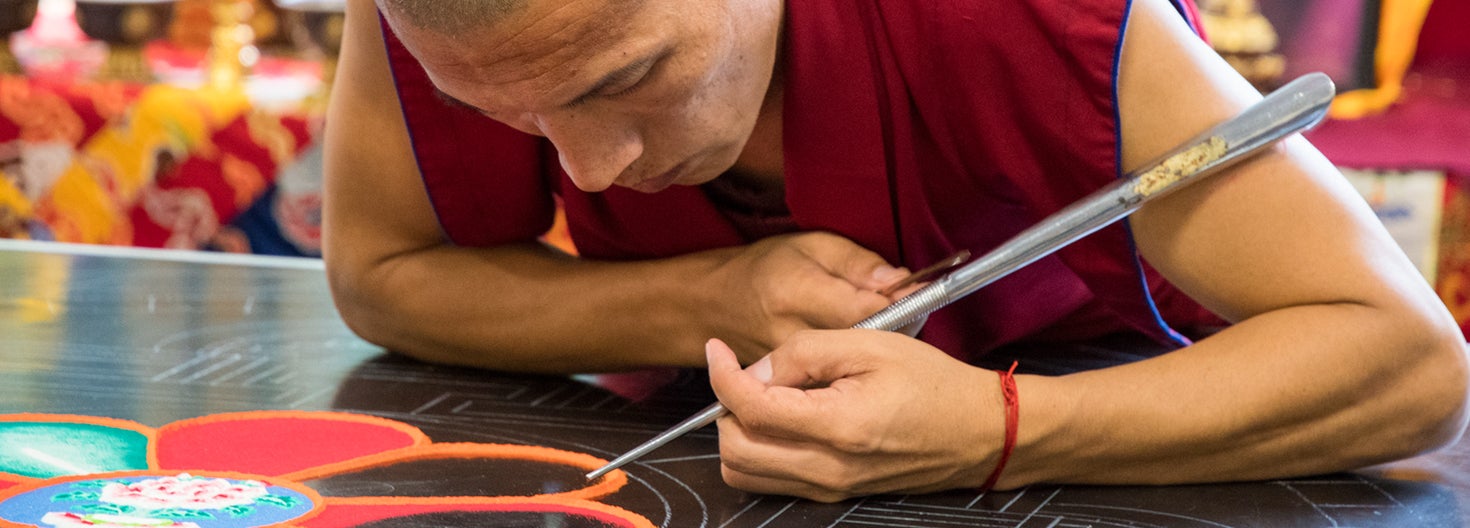
Developing compassion: It figures prominently in the work of URI’s Center for Nonviolence and Peace Studies this year. And, at the invitation of the Center, some special visitors to the University are bringing attention to the idea of cultivating compassion in the practicing of an art form that is more than 2,000 years old.
Seven Tibetan Buddhist monks of the Drepung Loseling Monastery visiting URI this week are working on a colored-sand mandala in the Memorial Union’s lounge. The monks, also called lamas, have created hundreds of such colored-sand mandalas for religious centers, museums, and colleges and universities. In complexity, beauty and vibrancy, mandalas rival cathedrals’ stained glass windows and, like them, invite contemplation — with one important distinction. Whereas a stained glass window is meant to last for centuries, a mandala’s longevity is measured in hours.
In Buddhist tradition, mandalas are destroyed to illustrate life’s impermanence. Come Friday, Sept. 22 at 12 p.m., the Avalokitesvara Mandala of Compassion the monks have created will be destroyed, as well.
In the meantime, the monks will paint from 10 a.m. to 6 p.m. through mid-morning Friday. The monks are part of The Mystical Arts of Tibet, a world tour endorsed by The Dalai Lama and co-produced by Richard Gere and the Drepung Loseling Monastery in Atlanta and India.
“Tibetans believe that the external world reflects the state of mind of its inhabitants. We believe that every individual has [the] potential to transform [their] minds and thereby contribute to environmental transformation,” said monk Nyima Tsering at Monday’s opening ceremony. “It is our hope that the creation of the mandala will contribute to healing, to harmony in this area, and to each of its inhabitants.”
The process
The construction of the mandala begins with the monks scouting for the optimal location, a process which includes getting permission from authorities both visible and invisible, Tsering said. The site is then consecrated through a ceremony involving chanting and meditation.

Photo by Nora Lewis
The monks then create an outline of the mandala on a wooden platform. Once completed, they begin the laying of the colored sand upon it. The sand is poured from metal tools, funnels called chak-purs. Monks hold the chak-pur in one hand and run a metal rod over its grated surface, which causes the sand to flow in fluid motion.
They work continuously for eight hours a day and always finish on time, noted Paul Bueno de Mesquita, professor of psychology at the University of Rhode Island and Center director.
The schedule
The monks’ visit coincides with the United Nations’ International Day of Peace, Sept. 21. The Center has planned a number of events in the quad in observation of the occasion including the formation of a human peace sign at 12:30 p.m., a performance by the Ukelele Peace Orchestra at 1:30 p.m., and a 7 p.m. candlelight vigil.
The public is invited to all events including the closing ceremony on Friday. Those present may choose to receive sand from the mandala. What remains will be taken to Ellery Pond and released in a gesture meant to spread the blessing of the mandala to the university and the greater community.
